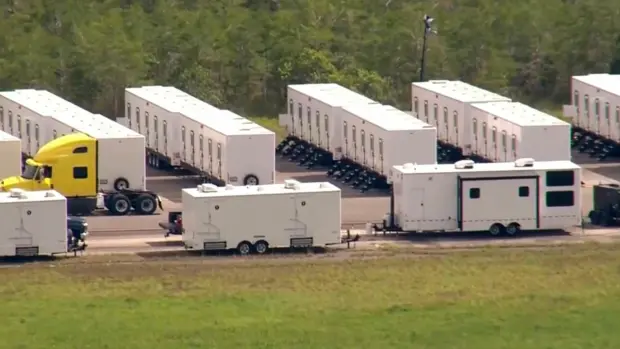The Dade-Collier Airport, a once-ambitious project nestled in the heart of Florida’s Everglades, is making headlines again in 2025. Originally envisioned as the world’s largest airport, this remote airfield has largely served as a training and transition hub for pilots. However, recent moves by Florida’s state government have thrust Dade-Collier Airport into the spotlight, sparking debates over its future use and environmental impact. From plans to transform it into a detention center dubbed “Alligator Alcatraz” to its ongoing role in aviation training, the airport’s story is evolving rapidly. Here’s a deep dive into the latest developments shaping this unique site.
A Controversial Plan for Dade-Collier Airport
In June 2025, Florida Governor Ron DeSantis announced a bold and polarizing initiative to repurpose Dade-Collier Airport as a temporary detention center for undocumented immigrants. Nicknamed “Alligator Alcatraz” by Florida Attorney General James Uthmeier, the plan leverages the airport’s 10,500-foot runway and remote location, surrounded by the Everglades’ swamps and wildlife, to house up to 1,000 detainees. The state aims to support federal immigration enforcement efforts under the Trump administration’s deportation agenda. Construction began swiftly, with trucks delivering trailers, portable restrooms, and generators to the site by June 24, 2025. State officials argue the isolated location, with natural barriers like alligators and pythons, makes it ideal for such a facility.
The move has sparked fierce opposition. Miami-Dade County Mayor Daniella Levine Cava, whose county owns the airport, expressed concerns about potential environmental damage to the fragile Everglades ecosystem. She rejected a $20 million offer from the state to purchase the land, citing a recent appraisal valuing it at $190 million. Critics, including local Democrats, have called the seizure a “land grab” and worry about the ecological consequences of construction in the Big Cypress National Preserve. Despite these objections, the state invoked emergency powers to take control of the site, with plans to have the facility operational by early July 2025.
- Detention Center Proposal: Florida plans to convert Dade-Collier Airport into “Alligator Alcatraz,” a 1,000-bed immigration detention center.
- State Seizure: Governor DeSantis used emergency powers to take control from Miami-Dade County after a rejected $20 million purchase offer.
- Environmental Concerns: Critics warn of potential harm to the Everglades ecosystem, a UNESCO World Heritage Site.
- Construction Timeline: Work began in June 2025, with operations expected to start within 30–60 days.
The Historical Context of Dade-Collier Airport
Dade-Collier Airport, also known as TNT (IATA: TNT, ICAO: KTNT), began in 1968 as the Everglades Jetport, a grand vision to build the world’s largest airport. Spanning 39 square miles, it was designed to handle supersonic jets like the Boeing 2707, with six runways and a monorail connecting to Miami and the Gulf of Mexico. Environmental concerns halted construction in 1970, leaving only one 10,499-foot runway. Today, the airport serves primarily as a training facility for commercial and military pilots, with its long runway ideal for practicing landings in low-visibility conditions. Its isolation ensures minimal interference with Miami International Airport’s traffic.
Despite its reduced role, the airport has seen occasional use for high-speed car races, leveraging the runway’s length to allow exotic vehicles to exceed 200 mph. Proposals for a Miami air show have surfaced periodically, including one in 2025 under former Mayor Carlos Gimenez, but were rejected due to logistical and environmental challenges. The airport’s 24,960 acres, with only 900 developed, remain a testament to its unrealized potential.
Environmental and Community Reactions
The transformation of Dade-Collier Airport into a detention center has reignited environmental debates. The airport sits near the Everglades National Park, a critical ecosystem home to alligators, herons, and black bears. Conservationists argue that any new construction risks disrupting this delicate habitat. A 1969 report that halted the original Jetport project warned of ecosystem destruction, a concern echoed today. Local residents and activists fear increased traffic and infrastructure could further strain the area.
Miami-Dade County officials, led by Mayor Levine Cava, have demanded transparency on the project’s scope and safeguards. The lack of firefighting or refueling facilities at the airport raises questions about its suitability for large-scale operations. Meanwhile, some community members see economic potential in revitalizing the site, though others view the detention center plan as a betrayal of the region’s environmental commitments.
What’s Next for Dade-Collier Airport?
As construction progresses, the future of Dade-Collier Airport hangs in the balance. The state’s rapid push to establish “Alligator Alcatraz” suggests a commitment to its immigration enforcement goals, but legal and environmental challenges may slow progress. Miami-Dade County could pursue legal action to reclaim control, while conservation groups are likely to ramp up advocacy. The airport’s role as a training facility continues, with pilots still using its runway for touch-and-go landings. However, its days of quiet obscurity may be over.
The debate over Dade-Collier Airport reflects broader tensions between development, conservation, and policy priorities. Whether it becomes a bustling detention center or remains a quiet training hub, its story captures the complexities of balancing progress with preservation in one of America’s most unique landscapes.
Stay informed about the future of Dade-Collier Airport by following local news outlets and environmental advocacy groups for real-time updates on this evolving story.
